December 2010
Taiwan OEMs beefing up on tablet technology
According to an article in the Taipei Times, leading Taiwanese OEMs are heavily investing in touch panel and tablet technologies. Compal, which is the world's second largest notebook contract manufacturer, is making a major investment in its brand-new Henghao Technology Co subsidiary that will be used for the purchase of a 4.5G Color Filter fab (see agreement) from Chunghwa Picture Tubes that can produce over 3 million touch sensor panels per month (from the specs, it appears 7-inch wide-screen). In addition to setting up Henghao Technology for glass-type projected capacitive touch-panel business, Compal also established a joint venture with Sitronix, a company that has developed voltage-driven multi-touch technology. -- Posted Wednesday, December 29, 2010
GammaTech D12C: Compact ruggedized convertible notebook with Intel Core i5 power
 GammaTech Computer Corp announced the D12C convertible notebook computer with a 12.1-inch wide-format WXGA (1280 x 800 pixel) touch display with optional digitizer. The compact and quite rugged D12C weighs just 5.5 pounds and is geared towards on-the-go sales staff, students, travelers, among others. The device is highly configurable via I/O module that provide anything from additional USB ports to Smart Card, second camera, 3G wireless or GPS. [See description and specs of the GammaTech D12C] -- Posted Friday, December 24, 2010
GammaTech Computer Corp announced the D12C convertible notebook computer with a 12.1-inch wide-format WXGA (1280 x 800 pixel) touch display with optional digitizer. The compact and quite rugged D12C weighs just 5.5 pounds and is geared towards on-the-go sales staff, students, travelers, among others. The device is highly configurable via I/O module that provide anything from additional USB ports to Smart Card, second camera, 3G wireless or GPS. [See description and specs of the GammaTech D12C] -- Posted Friday, December 24, 2010
"10 tablets that never quite took off"
This morning, one of my longterm PR contacts brought to my attention a feature entitled "10 tablets that never quite took off." It was published by itWorldCanada, which is part of Computerworld. Now Computerworld is one of the world's leading resources of excellent IT reporting, and has been for decades (I used to contribute to it in a former life as a corporate CIO), but the "slideshow" was disappointing and missed the point by listing some older tablets and mocking them. [Read more...] -- Posted Wednesday, December 22, 2010
VT Miltope RTSC-2: Core i7-based ultra-rugged military tablet
 The VT Miltope RTSC-2 is part of Miltope's recently introduced line of HARD WEAR rugged computers for demanding military environments. The RTSC-2 consists of the compact and very rugged RTCU-2 tablet and a vehicle dock that provides all sorts of additional connectivity and interface options. The tablet itself is the first (or among the first) to use an ultra-low voltage Intel Core i7 chip in this class, providing excellent performance at low power draw. The 10.4-inch display is exceptionally bright (1,000 nits), and the tablet underwent and passed the full gamut of MIL-STD-810G testing. [See description and specs of the VT Miltope RTSC-2] -- Posted Wednesday, December 22, 2010
The VT Miltope RTSC-2 is part of Miltope's recently introduced line of HARD WEAR rugged computers for demanding military environments. The RTSC-2 consists of the compact and very rugged RTCU-2 tablet and a vehicle dock that provides all sorts of additional connectivity and interface options. The tablet itself is the first (or among the first) to use an ultra-low voltage Intel Core i7 chip in this class, providing excellent performance at low power draw. The 10.4-inch display is exceptionally bright (1,000 nits), and the tablet underwent and passed the full gamut of MIL-STD-810G testing. [See description and specs of the VT Miltope RTSC-2] -- Posted Wednesday, December 22, 2010
Full review: Sprint Samsung Galaxy Tab
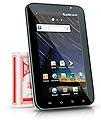 Something interesting happened in 2010. It was the year of the tablet, but there really weren't any tablets other than the iPad, which sold by the millions. But it was the year of the tablet nonetheless, with everyone discovering that tablets were, apparently, for real, just as three years ago everyone discovered that the iPhone, and what it represented, was for real. So everyone talked about their tablet plans in 2010, but only one company actually delivered an actual, live, real contender and alternative to the iPad, and that is Samsung with the Galaxy Tab you see here. Yes, Samsung delivered where others just promised, and that, too, may be a sign of things to come. [...more -- full review of the Samsung Galaxy Tab] -- Posted Friday, December 17, 2010
Something interesting happened in 2010. It was the year of the tablet, but there really weren't any tablets other than the iPad, which sold by the millions. But it was the year of the tablet nonetheless, with everyone discovering that tablets were, apparently, for real, just as three years ago everyone discovered that the iPhone, and what it represented, was for real. So everyone talked about their tablet plans in 2010, but only one company actually delivered an actual, live, real contender and alternative to the iPad, and that is Samsung with the Galaxy Tab you see here. Yes, Samsung delivered where others just promised, and that, too, may be a sign of things to come. [...more -- full review of the Samsung Galaxy Tab] -- Posted Friday, December 17, 2010
eMarketer predicts massive growth in tablet market
According to eMarketer, the worldwide market for tablets will more than quadruple in the next two years. According to their data, 13.3 million iPads will be sold in 2010 (of a total of 15.7 million total tablets). For 2011, eMarketer predicts 43.6 million tablets (34 million of them iPads), and for 2012 81.3 million (56.1 million iPads). Those are massive numbers indeed, and it'll be interesting to see if it all comes to pass. [See eMarketer article] -- Posted Friday, December 17, 2010
The Tablet Wars: Background and Outlook
Despite getting soundly trashed by a good number of industry experts when the iPad was first announced by Steve Jobs on January 27, 2010, Apple ended up selling about ten million of them in 2010, and predictions are that a lot more will be sold in the coming years. Everyone is scrambling to also have a tablet. Tablets are hot. The media now says tablets will demolish the netbook market, tablets will eat into notebook sales, Microsoft will gag and wither over having blown it with tablets, and so on and so on. Let's take a look at what's really happening, and what led to the current situation. [Read Conrad Blickenstorfer's "The Tablet Wars: Background and Outlook"] -- Posted Thursday, December 16, 2010
Full review: DLI 8800 rugged POS tablet
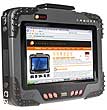 The Intel Atom-powered DLI 8800 is a compact, rugged tablet computer designed specifically for point-of-sale applications where retailers need to process payments, collect and exchange data, and communicate wirelessly both indoors and out. Of particular interest for POS applications is the 8800's 3-in-1 payment processing functionality that includes an integrated magnetic card reader, an integrated barcode scanner, and RFID for fully contactless payment transactions. Featuring a 7-inch touchscreen (or digitizer) and your choice of OS, the DLI 8800 is small and handy enough to be deployed almost anywhere, and tough enough to take quite a bit of abuse. [Read full review of the DLI 8800] -- Posted Wednesday, December 15, 2010
The Intel Atom-powered DLI 8800 is a compact, rugged tablet computer designed specifically for point-of-sale applications where retailers need to process payments, collect and exchange data, and communicate wirelessly both indoors and out. Of particular interest for POS applications is the 8800's 3-in-1 payment processing functionality that includes an integrated magnetic card reader, an integrated barcode scanner, and RFID for fully contactless payment transactions. Featuring a 7-inch touchscreen (or digitizer) and your choice of OS, the DLI 8800 is small and handy enough to be deployed almost anywhere, and tough enough to take quite a bit of abuse. [Read full review of the DLI 8800] -- Posted Wednesday, December 15, 2010
iPad on the Road -- Part V
Another road trip for the iPad. Carol and I flew to Tennessee for an extended Thanksgiving weekend, which meant I had to take along my electronic gear. We both packed our iPads, cameras, iPhones, and I also took along my big MacBook Pro. ... [read more...] -- Posted Wednesday, December 15, 2010
DT Research's rugged tablet lineup
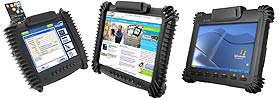 For years, San Jose, Calif., based DT Research was ahead of its time with their lineup of "information appliances." Now the market has caught up, tablets are hot, and DT Research has updated its tablet lineup with the WebDT 312, the WebDT 362, and the new WebDT 390, all based on the 1.6GHz Intel Atom Z530 and either Flash or SSD, and all available with a variety of different operating systems. All models are also far more rugged than consumer market tablets, and they are available with a variety of data collection technology (magstripe, RFID, smart card, scanners), making them uniquely suitable for all sorts of POS applications. -- Posted Tuesday, December 14, 2010
For years, San Jose, Calif., based DT Research was ahead of its time with their lineup of "information appliances." Now the market has caught up, tablets are hot, and DT Research has updated its tablet lineup with the WebDT 312, the WebDT 362, and the new WebDT 390, all based on the 1.6GHz Intel Atom Z530 and either Flash or SSD, and all available with a variety of different operating systems. All models are also far more rugged than consumer market tablets, and they are available with a variety of data collection technology (magstripe, RFID, smart card, scanners), making them uniquely suitable for all sorts of POS applications. -- Posted Tuesday, December 14, 2010
DAP Technologies introduces rugged, modular M4000 handhelds
 DAP Technologies has introduced the M4000 series of modular rugged handheld computers. Aiming to be a rugged, powerful, yet lightweight addition to DAP's full line of handhelds, tablets and panels, the Marvell PXA270/Windows CE 5.0 powered M4000 comes in two versions (numeric and alphanumeric keypads), both of which have a 3.5-inch QVGA display, 1D laser and 1D/2D imager options; WiFi, Bluetooth and optional WWAN and GPS. Sealed to IP65 specs, able to survive 5-foot drops and operate in a wide temperature range (-4 to 122F), the M4000 series models are designed to be versatile, expandable workhorse handhelds for a variety of manufacturing, warehousing, public safety, security and field service applications. [See description and specs of the DAP M4000 series] -- Posted Monday, December 13, 2010
DAP Technologies has introduced the M4000 series of modular rugged handheld computers. Aiming to be a rugged, powerful, yet lightweight addition to DAP's full line of handhelds, tablets and panels, the Marvell PXA270/Windows CE 5.0 powered M4000 comes in two versions (numeric and alphanumeric keypads), both of which have a 3.5-inch QVGA display, 1D laser and 1D/2D imager options; WiFi, Bluetooth and optional WWAN and GPS. Sealed to IP65 specs, able to survive 5-foot drops and operate in a wide temperature range (-4 to 122F), the M4000 series models are designed to be versatile, expandable workhorse handhelds for a variety of manufacturing, warehousing, public safety, security and field service applications. [See description and specs of the DAP M4000 series] -- Posted Monday, December 13, 2010
New: USB-to-HDMI adapter
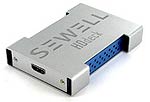 Want to watch video on your big flatscreen HDTV, but your computer doesn't have HDMI output? Sewell Direct to the rescue. Their new HDdeck USB to HDMI SW-3100 display adapter solves the problem for US$99.95. The SW-3100 is essentially a compact external video card that connects from any USB 2.0 port to your HDTV or compatible monitor. [See Sewell HDeck USB to HDMI] -- Posted Thursday, December 9, 2010
Want to watch video on your big flatscreen HDTV, but your computer doesn't have HDMI output? Sewell Direct to the rescue. Their new HDdeck USB to HDMI SW-3100 display adapter solves the problem for US$99.95. The SW-3100 is essentially a compact external video card that connects from any USB 2.0 port to your HDTV or compatible monitor. [See Sewell HDeck USB to HDMI] -- Posted Thursday, December 9, 2010
New study on mobile data usage: Android uses more than iPhone
Network management solutions provider Arieso conducted a series of studies, comparing subscriber demand for mobile data, that shows that different users and different devices exhibit markedly different demands on mobile networks. For example, iPhone 4 users are more hungry for data than their iPhone3G counterparts, typically making 44% more data calls, downloading 41% more data to their devices, and spending 67% more time connected to the network for data. However, Arieso's analysis also showed that Android devices have higher data call volumes, time connected to the network, and data volume uploaded and downloaded than both the iPhone3G and iPhone 4. [See Arieso summary]. -- Posted Thursday, December 9, 2010
TI introduces 1.5GHz dual Core OMAP4440 processor
While Texas Instruments' OMAP processor never had the same visibility in the mobile/handheld market as the Intel/Marvell XScale PXA chips, they've been around and have had some nice design wins. Now TI introduced the OMAP4440 that we'll probably see much more of. The chip includes dual ARM Cortex A9 cores running at 1.5GHz, supports 1080p video, hardware accelerated 2D/3D graphics with support of all major graphics APIs, up to 20-megapixel imaging and advanced onboard photography features, HDMI output and support of up to 1920 x 1200 pixel, USB 2.0, all supplying a massive performance boost for handhelds and tablets at remarkably low power consumption. [See TI OMAP4440 product bulletin] -- Posted Thursday, December 9, 2010
Psion announces upcoming low-cost EP10 rugged PDA
Psion Teklogix launched the new Psion EP10 handheld computer in Shanghai. Available in Q2 2011, the EP10 will list at less than $2,500 and is part of the company's "Open Source Mobility" modular technology platform strategy. The EP10 will be based on an 800MHz TI Sitara 3715 OMAP3 processor (XT10 has 600MHz version); have a 3.7-inch VGA display; offer WiFi, Bluetooth, 3G cellular (both CDMA EVDO Rev A and GSM HSPA+); and include digital compass, gyroscope, accelerometer and proximity sensor. Psion hopes the EP10 will attract business users who currently use standard, non-rugged consumer smartphones in the field. [See Psion press release on the EP10] -- Posted Thursday, December 9, 2010
The upcoming Internet collision
The Internet as we know it is on collision course. Almost everyone is on broadband now. Almost everything is moving towards streaming content. That means downloading massive amounts of data. Shouldn't be a problem, what with all those reports a couple of years ago of a vastly underutilized fiber optics infrastructure. But just when everything is switching to streaming content, the telcos and cable companies are switching to metered use, imposing limits and heavy charges on downloading, crippling downloads. It's modern day bridge toll robbery all over, and, if they get away with it, certainly a gold rush for telcos and cable providers. -- Posted Tuesday, December 7, 2010
Can BlackBerry survive?
Can BlackBerry survive the perfect storm of iPhone, Android, and now iPad? That's the title of an interesting look at RIM's chances of retaining relevance in the iPhone/iPad/Android era published in InfoWorld. Veteran road warriors will recall how RIM first elevated the good old pager into a bi-directional communications device, then took the (business) world by storm with its thumb-type PDAs with secure and efficient push email. Unfortunately, RIM has long lived in a bubble, dismissing the tech and enthusiast press (we once dedicated a full section of the magazine to RIM, in which RIM never showed the slightest interest), dismissing the app phenomenon, and just generally remaining stuck in the past. RIM may not follow Nokia into smartphone irrelevance, but a hefty wakeup call may be in order. -- Posted Tuesday, December 7, 2010
Motorola Solutions introduces MC55A0 rugged handheld
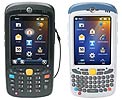 Motorola Solutions has introduced the MC55A0, a significant technology refresh of the MC55 platform of rugged handhelds. The new MC55A0 should be much faster thanks to a Marvel PXA320 processor, the new "PenTile" VGA display is very bright and sharp thanks to the addition of an additional white sub-pixel, the device is better sealed (IP64) and more rugged (6-foot drop), camera (3.2mp) and scanners (1D SE960 or 2D SE4500) have been improved, and it's now running WinMo 6.5. Note that there's VoIP but no WWAN on this model (for that you want to look at the MC65), and there is a healthcare version of the MC55A0. [See detailed description and specs of the Motorola MC55A0] -- Posted Tuesday, December 7, 2010
Motorola Solutions has introduced the MC55A0, a significant technology refresh of the MC55 platform of rugged handhelds. The new MC55A0 should be much faster thanks to a Marvel PXA320 processor, the new "PenTile" VGA display is very bright and sharp thanks to the addition of an additional white sub-pixel, the device is better sealed (IP64) and more rugged (6-foot drop), camera (3.2mp) and scanners (1D SE960 or 2D SE4500) have been improved, and it's now running WinMo 6.5. Note that there's VoIP but no WWAN on this model (for that you want to look at the MC65), and there is a healthcare version of the MC55A0. [See detailed description and specs of the Motorola MC55A0] -- Posted Tuesday, December 7, 2010
iPad helps Apple get #3 spot in worldwide mobile PC shipments
According to DisplaySearch, the iPad helped Apple pass Dell for the #3 spot in worldwide mobile PC unit shipments during Q3 of 2010. HP was #1 with 9.5 million units, Acer 2nd with 91. million, Apple 3rd with 6.3 million, Dell fourth with 6.1 million, and Toshiba 5th with 4.3 million. -- Posted Monday, December 6, 2010
Glove-capable Atmel maXTouch multi-touch now available for up to 15-inch displays
 The folks at Atmel are now shipping their new maXTouch mXT1386/mXT616 chipsets that can handle touchscreens up to 15 inches. Their patented QMatrix technology offers multi-touch with unlimited touch capability, low power consumption, and the ability to detect touches with a finger nail, stylus and gloves. If this sounds sounds too good to be true, it's not: Atmel's maXTouch is being used in various HTC phones and also in the Samsung Galaxy Tab (ours works flawlessly with gloves, even for multi-touch). [See Atmel maXTouch page] -- Posted Monday, December 6, 2010
The folks at Atmel are now shipping their new maXTouch mXT1386/mXT616 chipsets that can handle touchscreens up to 15 inches. Their patented QMatrix technology offers multi-touch with unlimited touch capability, low power consumption, and the ability to detect touches with a finger nail, stylus and gloves. If this sounds sounds too good to be true, it's not: Atmel's maXTouch is being used in various HTC phones and also in the Samsung Galaxy Tab (ours works flawlessly with gloves, even for multi-touch). [See Atmel maXTouch page] -- Posted Monday, December 6, 2010
 GammaTech Computer Corp announced the D12C convertible notebook computer with a 12.1-inch wide-format WXGA (1280 x 800 pixel) touch display with optional digitizer. The compact and quite rugged D12C weighs just 5.5 pounds and is geared towards on-the-go sales staff, students, travelers, among others. The device is highly configurable via I/O module that provide anything from additional USB ports to Smart Card, second camera, 3G wireless or GPS. [See description and specs of the GammaTech D12C] -- Posted Friday, December 24, 2010
GammaTech Computer Corp announced the D12C convertible notebook computer with a 12.1-inch wide-format WXGA (1280 x 800 pixel) touch display with optional digitizer. The compact and quite rugged D12C weighs just 5.5 pounds and is geared towards on-the-go sales staff, students, travelers, among others. The device is highly configurable via I/O module that provide anything from additional USB ports to Smart Card, second camera, 3G wireless or GPS. [See description and specs of the GammaTech D12C] -- Posted Friday, December 24, 2010 The VT Miltope RTSC-2 is part of
The VT Miltope RTSC-2 is part of  Something interesting happened in 2010. It was the year of the tablet, but there really weren't any tablets other than the iPad, which sold by the millions. But it was the year of the tablet nonetheless, with everyone discovering that tablets were, apparently, for real, just as three years ago everyone discovered that the iPhone, and what it represented, was for real. So everyone talked about their tablet plans in 2010, but only one company actually delivered an actual, live, real contender and alternative to the iPad, and that is Samsung with the Galaxy Tab you see here. Yes, Samsung delivered where others just promised, and that, too, may be a sign of things to come. [
Something interesting happened in 2010. It was the year of the tablet, but there really weren't any tablets other than the iPad, which sold by the millions. But it was the year of the tablet nonetheless, with everyone discovering that tablets were, apparently, for real, just as three years ago everyone discovered that the iPhone, and what it represented, was for real. So everyone talked about their tablet plans in 2010, but only one company actually delivered an actual, live, real contender and alternative to the iPad, and that is Samsung with the Galaxy Tab you see here. Yes, Samsung delivered where others just promised, and that, too, may be a sign of things to come. [ The Intel Atom-powered
The Intel Atom-powered  For years, San Jose, Calif., based
For years, San Jose, Calif., based 
 Want to watch video on your big flatscreen HDTV, but your computer doesn't have HDMI output?
Want to watch video on your big flatscreen HDTV, but your computer doesn't have HDMI output?  Motorola Solutions has introduced the MC55A0, a significant technology refresh of the MC55 platform of rugged handhelds. The new MC55A0 should be much faster thanks to a Marvel PXA320 processor, the new "PenTile" VGA display is very bright and sharp thanks to the addition of an additional white sub-pixel, the device is better sealed (IP64) and more rugged (6-foot drop), camera (3.2mp) and scanners (1D SE960 or 2D SE4500) have been improved, and it's now running WinMo 6.5. Note that there's VoIP but no WWAN on this model (for that you want to look at the MC65), and there is a healthcare version of the MC55A0. [See
Motorola Solutions has introduced the MC55A0, a significant technology refresh of the MC55 platform of rugged handhelds. The new MC55A0 should be much faster thanks to a Marvel PXA320 processor, the new "PenTile" VGA display is very bright and sharp thanks to the addition of an additional white sub-pixel, the device is better sealed (IP64) and more rugged (6-foot drop), camera (3.2mp) and scanners (1D SE960 or 2D SE4500) have been improved, and it's now running WinMo 6.5. Note that there's VoIP but no WWAN on this model (for that you want to look at the MC65), and there is a healthcare version of the MC55A0. [See  The folks at Atmel are now shipping their new
The folks at Atmel are now shipping their new